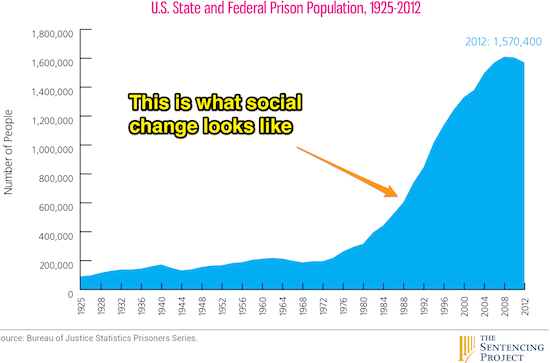I want my students to see that social change isn’t magic. That it is a social process directed by social forces. I want them to know that previous historical events often serve as antecedents to change. And finally I want them to experience how learning about the past can help us better understand our present and predict our future. These are the goals I set for myself every time I teach my Social Change class.
I pair these with the goals I have for every class I teach. For instance, I always want my students to learn about the scientific method, how to find and read peer-reviewed research, and how to write like a sociologist. Lastly, I want my students to develop the skill of creatively solving interesting problems because that it what they will be doing every day of their professional career. I always tell my students, if a question can be answered with a google search, no one will pay you to answer it.
“Align Your Goals With Your Assessments!”
Everyone tells us to align our teaching goals with what we are doing in the classroom and with the graded assessments. That is excellent advice and I think it’s safe to say we all aspire to have our goals, classroom activities, and assessments aligned. However, in reality it’s really hard to get all of your ducks in a row.
This semester I worked really hard to ensure that my student learning outcomes (SLOs) aligned with the written papers I assigned my students. Today I want to 1. give everyone a copy of my assignments and 2. discuss how I worked to get my goals and my assessments in line.
Student Learning Outcomes:
By the end of this class students will be able to…
- Analyze a social change event using sociological concepts/tools like social/historical contexts, social structure, sociological theory, materialist/idealist factors, etc.
- Answer a social change research question using peer-reviewed research. (aka think and write like a sociologist).
- Design a Direct action campaign to alter the power relations surrounding a social issue (aka creatively solve interesting social problems).
Paper 1: Analyze a Social Change Event

I decided to focus my class around one single example of social change: mass incarceration. I had my students read the first 2 chapters of Michelle Alexander’s The New Jim Crow. Alexander (2010) is making a clear argument that the War on Drugs (WoD) policies have recreated the racial caste system that has been with the United States since slavery. She walks the reader from slavery to vagrancy laws to Jim Crow laws to WoD polices arguing that each instance was a mutation of the prior system of oppression.
I ask my students to write down all of the social antecedents they see in the assigned two chapters. Then we worked together to create a list of antecedents (download here). The next day in class I draw a big time line across the double-wide white board at the front of the room. We worked together to fill the timeline with all of the crucial events and other social antecedents. With their antecedent list and timeline in hand, I have my students apply everything we’ve learned about social change from the rest of the class to the WoD and mass incarceration in paper 1.
Paper 2: Think & Write Like a Sociologist
One of the key ideas of social change is that if something hasn’t changed yet, then it’s probably because somebody else doesn’t want it changed. That’s my one sentence summary of Darhendorf’s (1959) Class and Class Conflict in Industrial Society. Really what we’re talking about here is hegemony and the social forces that maintain the status quo. I want my students to be able to identify those on each side of the WoD issue. I also want my students to develop their skills at doing literature reviews and using empirical evidence to support their arguments. Paper 2 combines both of these into a simple research paper.
Paper 3: Creatively Solve Interesting Problems
What good is knowing how things change if you don’t learn how to create some change yourself along the way? The book Organizing for Social Change is a workbook that guides you step-by-step through the process of fighting for social justice. The first two chapters explain what direct action organizing is and then the rest of the book is a series of worksheets and tasks to get your activist campaign off the ground. In paper 3 my students are challenged to plan a direct action campaign to mitigate the consequences of the WoD polices and mass incarceration in general.
This assignment is a “choose-your-own-adventure” style assignment. Students have to come up with their own ideas and then flesh out their campaign from there. As I write my students are working on this paper right now. Not a day has gone by that a student hasn’t said, “This is hard! I can’t think of any good ideas.” To which I always say, “Excellent! It sounds like you are doing the hard work of learning right now. Keep it up.”
While it might sound like I am enjoying their anguish, in reality I don’t. But I know that frustration, anger, and exhaustion are all common side effects of learning. Too often writing assignments are paint-by-numbers style activities. Students have grown accustomed to being told exactly what to write about, so open assignments like this give student the opportunity to creatively solve interesting problems.

Comments